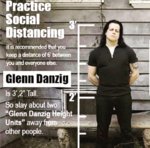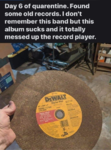My mom's 68 year old 1st cousin is a family physician (and a good one). She posted this on Facebook while practically begging people to read it.
-----------------------------------
From a group of 50 Brookline, MA physicians (sigs at the bottom):
“As there is so much confusion, misinformation and denial on social media about the coronavirus we hope to explain, in plain language, why the experts see this as such an emergency. Many people are reading the claim online that this virus is a lot like the viruses that cause colds, and that if you get it, it will probably just seem like a bad cold and you are very unlikely to die. Depending on who you are, this may be true, but there is more to this story that is key to our outcome as a community.
This is a coronavirus that is new to the human population. Although it is related to the viruses that cause colds, and acts a lot like them in many ways, nobody has ever been exposed to this before, which means nobody has any immunity to it.
The virus is now moving explosively through the human population, spreading through respiratory secretions and 10 times more contagious that the flu or cold. Although many people will recover, about 20% will wind up with a serious pneumonia that will require hospitalization. Some will be so ill from the pneumonia that they will die. We estimate this may be 2-3%, but it is higher in Italy’s experience, partially because the healthcare system was overwhelmed so rapidly. In those over age 70, the death rate is 8-20%.
So if a child catches it on a playdate, they can easily transmit it to their grandmother as easily as touching the same doorknob or countertop.
Scientists measure the spread of an epidemic by a number called R0, or “R naught.” That number is calculated this way: for every person who develops the illness, how many other people do they give it to before they are cured (or dead) and no longer infectious? The R0 for coronavirus appears to be a number close to 3 – an extremely frightening number for such a deadly disease.
Suppose you catch the virus. You will give it to 3 other people, and they will each give it to three others, and so forth. Here is how the math works, where you, the “index case,” are the first line:
1
3
9
27
81
243
729
2,187
6,561
19,683
59,046
177,147
531,441
1,594,323
4,782,969
14,348,907
So, in just 15 steps of transmission, the virus has gone from just one index case to 14.3 million other people. Those 15 steps might take only a few weeks. With school out and lots of playdates, maybe less. The first person may be young and healthy Brookline child, but many of those 14 million people will be old and sick, and they will likely die because they got a virus that started in one person's throat.
R0 is not fixed – it can be lowered by control measures. If we can get the number below 1, the epidemic will die out. This is the point of the quarantines and social distancing, but we are not doing it fast enough.
In the US, we have to slow down the virus. American hospitals, Boston hospitals, have limited resources. We have a fixed number of ventilators and an impending calamity on our hands. Our Italian critical care colleagues have shared with us that they simply do not have enough resources (ventilators, physicians and nurse, critical care beds), and are forced to choose who lives and dies based on old tenets of wartime triage.
Older patients do not even get a ventilator and die of their pneumonia. These are decisions nobody should have to face, and we are only 11 days behind Italy’s fate. Their hospitals are quite advanced, and we are no better in Boston. As doctors, we are desperately trying to prepare for the onslaught of patients in the coming weeks. It is already beginning. This is an opportunity for you as the district leadership the time to be aggressive and help us fight this by “Flattening the Curve”.
We implore you, as a group of Boston’s doctors preparing to fight this, to help us. Please send a new email to ALL the Brookline school district families. Social distancing is painful. We know that kids have cabin fever, they are pleading to see their friends, they may have birthday parties coming up or special events they have been looking forward to. All of us need to work and childcare is a big worry. But we need to overcome these issues and boredom for the coming weeks so that we can survive this with as few deaths as possible. What does that mean?
1) No playdates, not even 1:1.
2) No small gatherings, no meetings between a couple families, even for birthday parties.
3) Avoid trampoline parks, climbing gyms, restaurants, movie theaters, anything in an enclosed area. Many of these places are advertising increased cleaning and hygiene. This is not sufficient! Do not go.
4) Cancel planned vacations for the next month. Avoid airline travel that is not an emergency. Many airlines and rental agencies are offering penalty free cancellations.
5) Stay at home as much as possible. Work from home if you possibly can. You may have to go buy groceries and medicine, of course, but make the trips quick and purposeful.
6) Wash your hands thoroughly after you have been in public places, for a full 20 seconds, soaping up thoroughly and being sure to get between the fingers.
7) Please avoid disseminating social media claims that the situation is not serious or is being exaggerated. This is a national crisis and conveying misinformation to your friends and family may put their lives in danger.
Thank you for taking the time to read this and stay safe and healthy in the coming weeks.”
Respectfully,
Erika Rangel, MD, Director of Surgical Critical Care, Brigham and Women’s Faulkner Hospital
Shawn Rangel, MD, Pediatric Surgery, Children’s Hospital Boston
Asaf Bitton, MD, Executive Director Ariadne Labs and Internal Medicine, BWH
Daniel O’connor, MD, Pediatrics, Longwood Pediatrics and Children’s Hospital Boston
Beth O’connor, MD, Pediatrics, Roslindale Pediatrics
Vandana Madhavan, MD, Clinical Director of Pediatric Infectious Disease, MGH
Parag Amin, MD, Pediatrics, Centre Pediatrics
Christy Cummings, MD, Neonatology, Children’s Hospital Boston
Eric Bluman, MD, Orthopedic Surgery, BWH
Trimble Augur, MD, Internal Medicine, Hebrew Rehabilitation Center
Dasha Weir, MD, Pediatric gastroenterology
Amy Evenson Warren, Transplant Surgery, BIDMC
William Oldham, MD, PhD, Pulmonary and Critical Care Medicine, BWH
James Kryzanski, MD, Neurosurgery, Tufts Medical Center
Ben Zendejas-Mummert, MD, Pediatric Surgery, Children’s Hospital Boston
Johanna Iturrino Moreda, MD, Gastroenterology, BIDMC
David Berg, MD, Cardiology and Cardiac Critical Care, BWH
Jennifer Crombie, MD, Hematology Oncology, BWH
Jenifer Lightdale, MD, Chief of Pediatric Gastroenterology, U Mass Memorial Hospital
Wayne Tworetzky, MD, Pediatric Cardiology, Children’s Hospital Boston
Elaine Yu, MD, Endocrinology
Jonathan Li, Infectious Disease
Nancy Cho, MD, Surgical Oncology, BWH
Eric Sheu, MD, Minimally Invasive Surgery, BWH
Reza Askari, MD, Director, Surgical Critical Care, BWH
Cindy Lien, MD, Internal Medicine and Palliative Care, BIDMC
Hannah Parker, MD, OB/GYN
Alysa E. Doyle, PhD, Center for Genomic Medicine, MGH
Christopher Smith, MD, Internal Medicine, Charles River Medical Associates, Wellesley, MA
Maya Greer, NP, Children’s Hospital Boston
Rusty Jennings, MD, Pediatric Surgery, Children’s Hospital Boston
Emily Oken, MD, Professor of Population Medicine, BWH
Chinwe Ukomadu, MD, Head of Clinical Hepatology, Novartis
Jennifer Kaufman, MD, Internal Medicine, BWH
Ann Poduri, MD, MPH, Pediatric Neurology
Susan Yehle Ritter, MD, Rheumatology
Diego Martinucci, MD Psychiatry, Atrius Health
Shih-Ning Liaw, MD, Pediatric Palliative Care, Dana-Farber Cancer Institute/Boston Children’s Hospital
Wolfram Goessling, MD, Gastroenterology and Oncology, MGH
Paola Daza, Pediatrics, MGH
Juan Matute, Neonatology, MGH
John Ross, MD, Internal Medicine, BWH
Megan Sandel, MD, Pediatrics, Boston Medical Center
Kathy Calvillo, MD, Surgery, BWH
Christine Greco, MD, Anesthesia, Children’s Hospital Boston
Niteesh Choudhry, MD, PhD, Internal Medicine, BWH and Harvard T.H. Chand School of Public Health
Chandru Krishnan, MD, Ophthalmology, Tufts Medical Center
Amy Ship, MD, Internal Medicine, Associate Director of Medical Education, Atrius Health
Yen-Lin Evelyn Chen, MD, Radiation Oncology, MGH
Daihung Do, MD, Dermatology, BIDMC
Chloe Zera, MD, MPH, Maternal Fetal Medicine, BIDMC
Alejandra Barrero-Castillero, MD, MPH, Neonatology, Children’s Hospital Boston
Jesse Esch, MD, Pediatric Cardiology, Children’s Hospital Boston
Alison Packard, MD, OB/GYN, MGH
Vik Khurana, MD PhD, Chief Division of Movement Disorders, BWH
Tu-Mai Tran, MD, MSc, Family Medicine, BMC
Yu Liu, MD PhD, Internal Medicine, Bristol Myers Squibb
Yih-Chieh Chen, MD
Lily Li, MD, Allergy and Immunology, BWH



